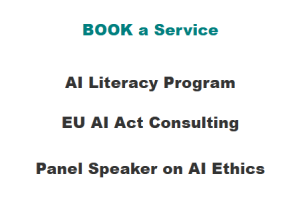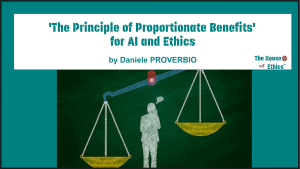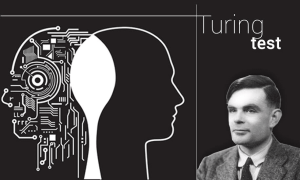AI for sustainability, sustainability for AI
Guaranteeing survival, prosperity and growth corresponds to aiming for sustainable development. Sustainability embraces three main pillars: economic, social and environmental.
“Artificial Intelligence” (AI) as a broad concept includes automated methods that reproduce human-like outputs and behaviors in various tasks. Currently, AI is based on highly advanced machine-learning techniques: computational methods that combine statistics and numerical optimization to recognize and reproduce patterns, interpret and generate digital inputs and outputs (such as texts, images, and other items that can be mapped to numerical matrices).
The development of sustainable solutions, as well as the skyrocketing of AI capabilities and diffusion within academia, industry and society, are recently colliding – up to the point that we cannot neglect the role of AI in pursuing sustainable goals, nor we cannot be blind in developing AI that is not sustainable.
In fact, AI can be a powerful asset in driving sustainable solutions; at the same time, AI should be itself sustainable, so as to integrate with its very solutions and mitigate the risk of having yet another technology that will soon require convoluted new solutions for its own sustainability.
AI for sustainability
Much research efforts and investments in AI-driven startups for sustainability show the growing interest in AI solutions to support sustainable goals. Key examples include the release of powerful predictive models towards climate action, adaptation and mitigation of climate-related risks, as well as the development of warning systems against disasters. Another domain where AI models can prove their worth is energy management – from the optimization of energy consumption and dispatchment over smart grid, to the management of batteries or coordination of energy communities.
AI models are also widespread among solutions for sustainable agriculture: their augmented flexibility helps to overcome the limitations of simpler models to manage crop rotations, pesticide usage and irrigation, as well as for logistics and waste management. The latter point also involves circular economy, whose efficiency and transparency can be improved by the use of AI models.
Another domain where much R&D efforts are dedicated, is the optimization of traffic flows, mobility and smart infrastructures in sustainable cities.
Projected to host about 68% of the world’s population by 2050, cities require drastic re-thinking in their design and management of services for citizens; AI-based predictive models may help urban planners and decision-makers to integrate various features and goals for the well-being of inhabitants and of the environment.
AI for social and economic sustainability is another area for great opportunities. A recent report identified numerous case studies where AI could play a significant role for social cohesion and well-being – from reducing language barriers thanks to automated translation to supporting education access for neurodivergent people, to providing more fair and democratic health treatments. However, there is currently far less debate about these dimensions and their interconnections, compared to the greater attention towards environmental sustainability.
In general, it appears that only a limited subset of SDG (sustainable development goals) are recognized, where AI potential is perceived as moderate to high: mainly, health, climate action and quality education are thought to be fields where AI can shine, and where investments are prominent. Other SDGs, such as reducing inequalities or promoting peace and strong institutions, are seen as having less potential. In particular, experts are increasingly concerned about the possibilities of malicious double use of AI in these domains, about the challenges on fairness and bias handling, as well as about data privacy. A recent article even argues that, for AI to significantly contribute to social and economic sustainability, it should be drastically reconsidered in its inception and deployment, by embedding ethics in its very structure, rather than adding it on as a byproduct. Of particular concern are the most recent AI algorithms (Large Language Models – LLMs – and generative AI), while more “traditional” machine learning and deep learning approaches are often more technical and focused on scientific and engineering problems, in turn mostly aimed at environmental sustainability and healthcare.
Overall, these research and investment directions show promising avenues for the application of AI in various tasks, geared towards a more sustainable future. However, some aspects should be considered when assessing the overall impact of AI for sustainable development.
The current applications are mostly oriented towards optimization, cost reduction and mitigation of consumption. Even in the social domain, there is little evidence of systematic efforts towards SDGs, except for democratizing access to education – which is a praiseworthy endeavor, but shouldn’t be the only one, and anyway requires infrastructures, energy and social safety to be fully promoted.
Key challenges such as economic and digital divide, awareness and environment protection, improvement of inequalities (gender, ethnic, access to healthcare) are, instead, less of a priority.
On the contrary, the divides and inequalities may augment due to uneven access, biases in language usage, or sovereignty and access to AI tools – which are still based on resources such as hardware, energy, training sets, costs.
Sustainability for AI
AI comes with dilemmas that are not yet fully tackled not solved. For instance, we have discussed the potential positive impact of AI in driving a green revolution by optimizing consumption and energy loads; on the other hand, it presents amplified resource demands beginning to rival the energy consumption requirements of whole industries or even nations. In this regard, most energy demand and CO2 emissions do not come from individual prompts (when it comes to LLMs) or single runs, but rather from the massive hardware (and the whole ecosystem behind data centers, including e-waste augmented by the rapid obsolescence of electronic devices) to support the algorithms, the data collection, curation and storage phases, and the training processes.
The net advantage or increased demands in terms of energy consumption and carbon footprint are not yet fully understood, and are extremely challenging to estimate in any case.
Similarly, on the social side, it is still unclear how to assess the tradeoff between broader access to educational tools powered by AI, versus the drawbacks raised by uneven access to technology in school or by the blurred legislation pertaining students’ data.
As a consequence, greater attention is being recently devoted by scholars and legislators to the concept of sustainability for AI, so as to embed guidelines and best practices in the development of AI and its related ecosystem.
Below, we survey key best practices and priority attention domains for each sustainability pillar, which are being or should be taken into account to develop sustainable AI.
We have already touched upon the challenges of AI’s environmental impact. Handling and fueling data centers is first and foremost the biggest challenge. Carbon-neutral facilities are greatly sought-for, and numerous strategies are being tested – from backing them with solar panels, to partially sinking them in marine water for cooling, up to seeking hospitality in space.
Federated learning and edge computing are explored alternatives to host AI on distribute low-power devices and thus reduce energy costs. Quantum AI is a new frontier to (hopefully) abate energy consumption and boost predictive performance, but is much in its infancy.
Despite the efforts towards energy consumption, however, fewer solutions exist against land use, water consumption, or the exploit of rare earths and minerals used for hardware construction and maintenance. E-wastes, as already mentioned, are another key challenge that still demands great attention: lifecycle approaches to AI-related wastes require circular economy principles that are still under development. Overall, steps are being made towards an environmentally-sustainable AI, but the road still requires many interventions – both technological and logistic.
Social sustainability is already threatened by the uncontrolled diffusion of generative AI applications in societies. Inclusivity, ethics, fairness, accountability, and other institutional and democratic principles at the base of social inclusion are challenged by algorithms developed without these in mind.
Biases of various nature, easy and free access to potentially dangerous information, misinformation in automated responses, unfiltered training and pollution of algorithms – they all put social balance and democratic foundations at risk. Accelerating the consensus around governance and regulation, as well as embedding ethical frameworks in the design and evaluation of the next generation of AI algorithms, will promote better and human-centric models.
Extending best practices for the evaluation of technologies meant for public use, such as stress-testing and red teaming, has the potential to promote more robust and trustworthy products for the global markets. Promoting inclusive AI training and deployment (including involving marginalized communities and interdisciplinary experts) would mitigate biases associated with unbalanced training data; fostering digital literacy and education at all levels would equip citizens with tools to better navigate a changing landscape.
Finally, economic sustainability is a key issue that is rapidly emerging after the first massive cycle of hype and investments. While, currently, AI growth is primarily fueled by private and public investments, its economy hasn’t reached maturity, especially in the field of generative AI where sustained revenue streams are still sought for. On the business level, adoption of AI is already uneven geographically and among big and small-medium companies – and the gap is projected to widen without capillary support, training and incentives to adopt. In turn, this may produce technological and economic divides that risk to jeopardize the current balance in productivity and business capacity. Developing sustainable business models for AI and powered by AI, which balance innovation with accountability, as well as democratizing access to AI tools, will prove invaluable for long-term growth.
Beyond key topics…
Sustainability and AI are two key topics that shape the social, economic and technological landscape of our times. Albeit AI can be a powerful driver towards a sustainable future, its role, net impact and balance of promises and challenges are not yet fully verified, and many questions remain as of whether the environmental and social disruption brought about by data centers and broad-use algorithms is backed with commensurable benefits. Although many use cases of AI use to foster SDGs exist, talking about “AI for sustainability” is still debatable and subject to further scrutiny.
On the other hand, experts have recognized a number of key interventions to make AI itself more sustainable on all aspects – environmental, social and economic. Such interventions would require strategic planning and investments by both authorities as well as industry leaders, to promote a shift towards “sustainability by design” principles. Moreover, sustainability paradigms are expected to integrate with the sibling requirements of ethics and compliance, to build trust and drive a transitions towards a future where humans are backed up by sustainable and human-centric AI.










